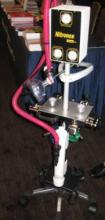SAN FRANCISCO – For much of the past decade, most pregnant women in the United States have not had access to nitrous oxide for analgesia during labor because the only company that sold a nitrous oxide machine for obstetrics in this country stopped making it.
This year, though, "laughing gas" for labor pain is back.
The Nitronox system delivers a fixed mixture of 50% oxygen and 50% nitrous oxide that is safe, effective, inexpensive, simple, and popular with many laboring women, said Judith T. Bishop, C.N.M., M.P.H. Physician supervision is not needed for its use, she added at a meeting on antepartum and intrapartum management sponsored by the University of California, San Francisco (UCSF).
Other nitrous oxide systems commonly are used for labor analgesia in the United Kingdom, Canada, Australia, and Scandinavia, and are available in Japan and Israel, but the gas has never caught on extensively in the United States for obstetrics. "I’ve been doing kind of a road show for nitrous oxide for about 7 years now," said Ms. Bishop, professor of obstetrics and gynecology and reproductive sciences at the university. "Ironically, during the entire period that I’ve been enthusiastically sharing my 20 years of experience with nitrous oxide use at UCSF, the nitrous oxide equipment appropriate for use in labor has been unobtainable" in the United States.
Michael Civitello, a salesman for the company that makes the Nitronox system, said the equipment went out of production during changes involving corporate mergers, not for reasons related to the product itself. Parker Hannifin Corporation’s Porter Instrument Division decided to return Nitronox to the market when it realized it still had a sales niche and advocates such as Ms. Bishop built increased interest in its use, he said in an interview at the company’s booth at the meeting. The new system costs approximately $5,000.
Perhaps 20-30 more hospitals and birth centers are expected to be offering nitrous oxide for labor by the end of this year, predicted Ms. Bishop and Mr. Civitello.
Women in labor at UCSF have been offered nitrous oxide for more than 30 years with no break in service because the gas delivery systems were built into the hospital, and are being built into a new UCSF hospital that’s under construction. Ms. Bishop searched and was able to find only three other U.S. hospitals with the ability to offer nitrous oxide during labor: the University of Washington, Seattle ("although they had largely forgotten about it," she said); a hospital in Lewiston, Idaho; and Vanderbilt University in Nashville, Tenn., which got tired of waiting for a nitrous oxide machine to return to the market and bought two used machines on eBay in 2011, Ms. Bishop said.
Data from Vanderbilt from June 2011 to May 2013 show an epidural rate of 40% in its midwifery service, compared with approximately 85% in the rest of the university practice, she said. Twenty percent of women in labor initiated nitrous oxide, and approximately 45% of those converted to epidural analgesia.
Data from 5,987 term singleton pregnancies at UCSF during 2007-2011 show an epidural rate of 76%. Nitrous oxide analgesia was started in 14% of deliveries, 41% of which converted to epidural analgesia.
Those numbers do not include other uses for nitrous oxide on labor and delivery units, she added, including analgesia for women experiencing laceration repair, retained placenta, Foley balloon placement, vaginal exams, and blood draws or IV placement.
For labor, nitrous oxide is an adjunct for pain relief and is not meant to replace other analgesia alternatives, Ms. Bishop said. Its use may allow the woman to delay or avoid using narcotics or epidural anesthesia. Nitrous oxide may be especially useful for women who want an epidural but can’t have one because they arrived at the hospital too late, they have a contraindication such as low platelet levels, or an anesthesiologist is unavailable to administer an epidural.
Another good use of nitrous oxide is for teenage mothers who are "out of control and can’t handle a needle in the back" for epidural analgesia, added Tekoa L. King, C.N.M., M.P.H., also of UCSF.
"There’s an antianxiety effect as well as an analgesic effect," Ms. Bishop said.
Data suggest that about half of women find nitrous oxide to be effective analgesia, better than the satisfaction rate for opioids in labor. That’s "no surprise," because opioids are not very effective in labor, she said. "Bathtubs are rated much more highly than opioids."


